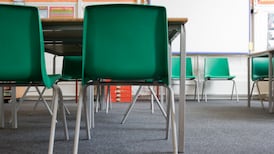The Iraqi city is scarred by a 1988 atrocity that left 5,000 civilians dead, writes Michael Jansenin Halabja
THE SHIMMERING white and gold city of Halabja sprawls across a broad green plain a few kilometres from Iraq’s fateful frontier with Iran.
Halabja is more than a place on a map. Halabja is a monument to man’s inhumanity to man.
On March 16th, 1988, during the desperate closing days of the eight-year Iraq-Iran war, this substantial city, then inhabited by 80,000 people, was attacked by the Iraqi air force.
Five-thousand civilians, the majority elderly men, women and children, were killed and 10,000 injured. Halabja became another atrocity in the annals of Iraq’s long and violent history.
The memorial to this event, a modern circular building with a high ribbed tent-like roof, stands on the outskirts of the city. It was inaugurated in 2003 after the US conquest of Iraq. Among the dignitaries who attended was then US secretary of state Colin Powell.
Inside the building is a rotunda with the colours of the Kurdish flag draped at the centre. A wall of black granite bears the names of the victims of the attack. Tewfiq, the guide, who was 10 at the time of the raid, says the bombing began at 11.35am with napalm shells. “People were not alarmed because they had used napalm many times,” he says.
But on that day, the Iraqis also dropped a cocktail of poisonous gases that enveloped entire neighbourhoods.
The exhibits in adjacent rooms feature photographs taken soon after the raid, as well as paintings of houses where mannequins of men, women and children lie in attitudes of dying and death.
Tewfiq’s family fled to Iran on foot along with thousands of other survivors.
Ali Hassan al-Majid – former Iraqi president Saddam Hussein’s cousin, known as “Chemical Ali” – was executed on January 27th this year for ordering the Halabja attack.
While the use of chemical weapons was unjustified and a vicious violation of the laws of war, Halabja was a legitimate military objective held by Kurdish peshmerga guerrillas who were fighting on Iran’s side. Iranian troops may also have been in the town, according to an investigative journalist who conducted interviews with survivors in 1993.
The monument, constructed by Kurdish leader Jalal Talabani, is resented by the people of Halabja, who claim they never received funds donated to help rebuild their city and reclaim their lives.
“We saw none of this money,” says Tewfiq.
On March 16th, 2006, several thousand Halabja residents rioted and burnt the memorial, which has since been restored.
The city, jerry-built by its impoverished citizens, is a jumble of unplanned, unpaved roads and unfinished breeze-block houses roofed with sheets of plastic held in place with rocks. Only the well- to-do can afford to plaster walls and construct proper roofs.
Men in baggy boiler suits with their heads enclosed in neat turbans mind shops displaying apples from Iran, cucumbers from Syria, aubergines and peppers from Turkey, bananas from Ecuador, and locally grown radishes as large as oranges.
Women in long dresses, heads covered with scarves, flock to shops selling material and clothing.
Conservative Halabja is a Muslim fundamentalist stronghold.
A second memorial to Halabja’s victims stands on a hill overlooking the ruins of the stone-built village of Anap.
This monument, commissioned by Danielle Mitterrand, wife of France’s late president, consists of white geometric concrete structures representing the bombing of the city.
Spring has graced the site with tiny yellow and pink flowers.
The 360-degree view is spectacular. To the northwest looms the rugged snow-capped Zagros range and its green velvet foothills. A few degrees south lies Halabja, veiled in dust; on its far side Talabani’s memorial museum. Running east is the brown ribbon of road to the Iranian border travelled by white pick-ups loaded with plastic jerry cans of petrol strapped atop stacks of tyres. Here smuggling is open and carried on in daylight, reinforcing the connection with Tehran, as close today as it was that fatal March day in 1988 when Halabja paid a high price for fighting against Baghdad.








